
Concept explainers
a)

Interpretation:
The products of the reaction along with the mechanism of the reaction are to be given.
Concept introduction:
The base catalyzed nitrile hydrolysis into an amide which is then further hydrolyzed to a carboxylate anion and ammonia takes place through the following steps. i) Nucleophilic attack of the hydroxide ion to the cyanide triple bond to yield an imideanion. ii)Protonation of the imine anion by water to yield a hydroxylamine.iii) Tautomerization of the hydroxylimine to an amide iv) Hydrolysis of the amide to carboxylate anion and ammonia.
To give:
The products of the reaction along with the mechanism of the reaction.
Answer to Problem 23MP
The products of the reaction are ammonia and hexanoic acid.
The mechanism of the reaction is given below.
Formation of the amide:

Hydrolysis of the amide:
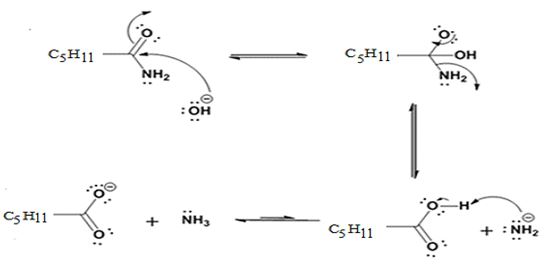
Where C5H11 = -CH2CH2CH2CH2CH3
Explanation of Solution
The nucleophilic attack of the hydroxide ion the nitrile carbon in hexanenitrile yields an imine anion as the product which in the next step gets protonated to produce a hydroxylimine. The hydroxylamine then tautomerizes to give hexanamide.
The nucleophilic attack of the hydroxide ion on the carbonyl carbon of the amide and subsequent loss an amide ion yields hexanoic acid. The deprotonation of the acid by the amide anion leads to the formation of carboxylate anion with the liberation of ammonia.
The products of the reaction are ammonia and hexanoic acid.
The mechanism of the reaction is given below.
Formation of the amide:

Hydrolysis of the amide:

Where C5H11 = -CH2CH2CH2CH2CH3
b)

Interpretation:
The products of the reaction along with the mechanism of the reaction are to be given.
Concept introduction:
The base catalyzed nitrile hydrolysis into an amide which is then further hydrolyzed to a carboxylate anion and ammonia takes place through the following steps. i) Nucleophilic attack of the hydroxide ion to the cyanide triple bond to yield an imideanion. ii)Protonation of the imine anion by water to yield a hydroxylamine.iii) Tautomerization of the hydroxylimine to an amide iv) Hydrolysis of the amide to carboxylate anion and ammonia.
To give:
The products of the reaction along with the mechanism of the reaction.
Answer to Problem 23MP
The products of the reaction are ammonia and cyclobutanecarboxylate anion.
The mechanism of the reaction is given below.
Formation of the amide:
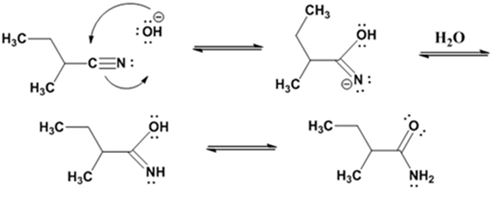
Hydrolysis of the amide:
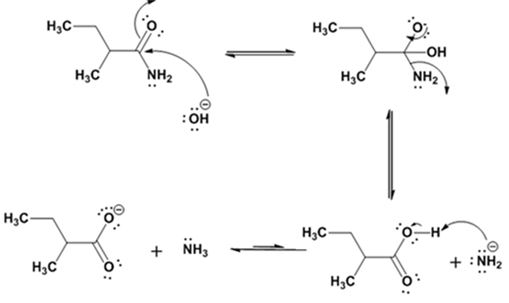
Explanation of Solution
The nucleophilic attack of the hydroxide ion the nitrile carbon in 2-methylbutanenitrile yields an imine anion as the product which in the next step gets protonated to produce a hydroxylimine. The hydroxylamine then tautomerizes to give 2-methylbutanamide.
The nucleophilic attack of the hydroxide ion on the carbonyl carbon of the amide and subsequent loss an amide ion yields butanoic acid. The deprotonation of the acid by the amide anion leads to the formation of carboxylate anion with the liberation of ammonia.
The products of the reaction are ammonia and cyclobutanecarboxylate anion.
The mechanism of the reaction is given below.
Formation of the amide:

Hydrolysis of the amide:

c)

Interpretation:
The product of the reaction is to be given along with the mechanism of the reaction.
Concept introduction:
The base catalyzed nitrile hydrolysis into an amide which is then further hydrolyzed to a carboxylate anion and ammonia takes place through the following steps. i) Nucleophilic attack of the hydroxide ion to the cyanide triple bond to yield an imideanion. ii)Protonation of the imine anion by water to yield a hydroxylamine. iii) Tautomerization of the hydroxylimine to an amide iv) Hydrolysis of the amide to carboxylate anion and ammonia.
To give:
The products of the reaction along with the mechanism of the reaction.
Answer to Problem 23MP
The products of the reaction are ammonia and m-methylbenzamide.
The mechanism of the reaction is given below.
Formation of the amide:
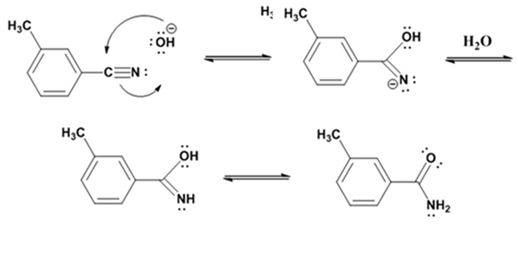
Hydrolysis of the amide:
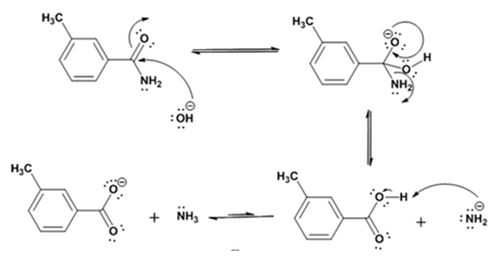
Explanation of Solution
The nucleophilic attack of the hydroxide ion the nitrile carbon in m-methylbenzonitrile yields an imine anion as the product which in the next step gets protonated to produce a hydroxylimine. The hydroxylamine then tautomerizes to give 3-methylbenzamide.
The nucleophilic attack of the hydroxide ion on the carbonyl carbon of the amide and subsequent loss an amide ion yields m-methylbenzoic acid. The deprotonation of the acid by the amide anion leads to the formation of the carboxylate anion with the liberation of ammonia.
The products of the reaction are ammonia and m-methylbenzamide.
The mechanism of the reaction is given below.
Formation of the amide:

Hydrolysis of the amide:

d)

Interpretation:
The products of the reaction along with the mechanism of the reaction is to be given.
Concept introduction:
The base catalyzed nitrile hydrolysis into an amide which is then further hydrolyzed to a carboxylate anion and ammonia takes place through the following steps. i) Nucleophilic attack of the hydroxide ion to the cyanide triple bond to yield an imideanion. ii)Protonation of the imine anion by water to yield a hydroxylamine.iii) Tautomerization of the hydroxylimine to an amide iv) Hydrolysis of the amide to carboxylate anion and ammonia.
To give:
The products of the reaction along with the mechanism of the reaction.
Answer to Problem 23MP
The products of the reaction are ammonia and cyclobutanecarboxylate ion.
The mechanism of the reaction is given below.
Formation of the amide:
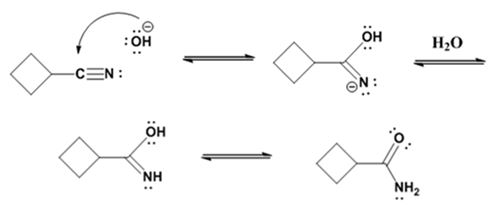
Hydrolysis of the amide:

Explanation of Solution
The nucleophilic attack of the hydroxide ion the nitrile carbon in cyclobutanenitrile yields an imine anion as the product which in the next step gets protonated to produce a hydroxylimine. The hydroxylamine then tautomerizes to give cyclobutanecarboxylamide.
The nucleophilic attack of the hydroxide ion on the carbonyl carbon of the amide and subsequent loss an amide ion yields cyclobutane
The products of the reaction are ammonia and cyclobutanecarboxylate ion.
The mechanism of the reaction is given below.
Formation of the amide:

Hydrolysis of the amide:

Want to see more full solutions like this?
Chapter 20 Solutions
Organic Chemistry
- Calculating the pH at equivalence of a titration 3/5 Izabella A chemist titrates 120.0 mL of a 0.7191M dimethylamine ((CH3)2NH) solution with 0.5501 M HBr solution at 25 °C. Calculate the pH at equivalence. The pk of dimethylamine is 3.27. Round your answer to 2 decimal places. Note for advanced students: you may assume the total volume of the solution equals the initial volume plus the volume of HBr solution added. pH = ☐ ✓ 18 Ar Boarrow_forwardAlcohols can be synthesized using an acid-catalyzed hydration of an alkene. An alkene is combined with aqueous acid (e.. sulfuric acid in water). The reaction mechanism typically involves a carbocation intermediate. > 3rd attempt 3343 10 8 Draw arrows to show the reaction between the alkene and hydronium ion. that 2nd attempt Feedback 1st attempt تعمال Ju See Periodic Table See Hint F D Ju See Periodic Table See Hintarrow_forwardDraw the simplified curved arrow mechanism for the reaction of acetone and CHgLi to give the major product. 4th attempt Π Draw the simplified curved arrow mechanism T 3rd attempt Feedback Ju See Periodic Table See Hint H -H H -I H F See Periodic Table See Hintarrow_forward
- Select the correct reagent to accomplish the first step of this reaction. Then draw a mechanism on the Grignard reagent using curved arrow notation to show how it is converted to the final product. 4th attempt Part 1 (0.5 point) Select the correct reagent to accomplish the first step of this reaction. Choose one: OA Mg in ethanol (EtOH) OB. 2 Li in THF O C. Li in THF D. Mg in THF O E Mg in H2O Part 2 (0.5 point) Br Part 1 Bri Mg CH B CH, 1 Draw intermediate here, but no arrows. © TE See Periodic Table See Hint See Hint ין Harrow_forwardSelect the product for the following reaction. HO HO PCC OH ○ OH O HO ○ HO HO HOarrow_forward5:45 Х Select the final product for the following reaction sequence. O O 1. Mg. ether 2.D.Oarrow_forward
- Based on the chart Two similarities between the molecule with alpha glycosidic linkages. Two similarities between the molecules with beta glycosidtic linkages. Two differences between the alpha and beta glycosidic linkages.arrow_forwardplease help fill in the tablearrow_forwardAnswer F pleasearrow_forward
- 4. Refer to the data below to answer the following questions: The octapeptide saralasin is a specific antagonist of angiotensin II. A derivative of saralasin is used therapeutically as an antihypertensive. Amino acid analysis of saralasin show the presence of the following amino acids: Ala, Arg, His, Pro, Sar, Tyr, Val, Val A.Sar is the abbreviation for sarcosine, N-methyl aminoethanoic acid. Draw the structure of sarcosine. B. N-Terminal analysis by the Edman method shows saralasin contains sarcosine at the N-terminus. Partial hydrolysis of saralasin with dilute hydrochloric acid yields the following fragments: Tyr-Val-His Sar-Arg-Val His-Pro-Ala Val-Tyr-Val Arg-Val-Tyr What is the structure of saralasin?arrow_forwardWhat is the structure of the DNA backbone?arrow_forwardPLEASE PLEASE PLEASE use hand drawn structures when possarrow_forward

 EBK A SMALL SCALE APPROACH TO ORGANIC LChemistryISBN:9781305446021Author:LampmanPublisher:CENGAGE LEARNING - CONSIGNMENT
EBK A SMALL SCALE APPROACH TO ORGANIC LChemistryISBN:9781305446021Author:LampmanPublisher:CENGAGE LEARNING - CONSIGNMENT Organic ChemistryChemistryISBN:9781305580350Author:William H. Brown, Brent L. Iverson, Eric Anslyn, Christopher S. FootePublisher:Cengage Learning
Organic ChemistryChemistryISBN:9781305580350Author:William H. Brown, Brent L. Iverson, Eric Anslyn, Christopher S. FootePublisher:Cengage Learning


